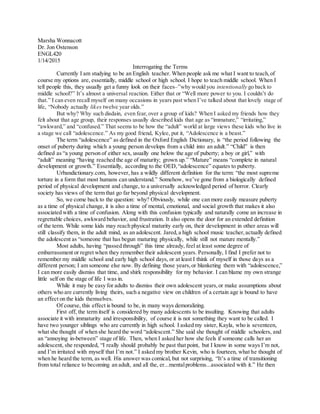
Adolescence As A Constructed Term
- 1. Marsha Wonnacott Dr. Jon Ostenson ENGL420 1/14/2015 Interrogating the Terms Currently I am studying to be an English teacher. When people ask me what I want to teach,of course my options are, essentially, middle school or high school. I hope to teach middle school. When I tell people this, they usually get a funny look on their faces–”why would you intentionally go back to middle school?” It’s almost a universal reaction. Either that or “Well more power to you. I couldn’t do that.” I can even recall myself on many occasions in years past when I’ve talked about that lovely stage of life, “Nobody actually likes twelve year olds.” But why? Why such disdain, even fear,over a group of kids? When I asked my friends how they felt about that age group, their responses usually described kids that age as “immature,” “irritating,” “awkward,” and “confused.” That seems to be how the “adult” world at large views these kids who live in a stage we call “adolescence.” As my good friend, Kylee, put it, “Adolescence is a beast.” The term “adolescence” as defined in the Oxford English Dictionary, is “the period following the onset of puberty during which a young person develops from a child into an adult.” “Child” is then defined as “a young person of either sex, usually one below the age of puberty; a boy or girl,” with “adult” meaning “having reached the age of maturity; grown up.” “Mature” means “complete in natural development or growth.” Essentially, according to the OED,“adolescence” equates to puberty. Urbandictionary.com, however, has a wildly different definition for the term: “the most supreme torture in a form that most humans can understand.” Somehow, we’ve gone from a biologically defined period of physical development and change, to a universally acknowledged period of horror. Clearly society has views of the term that go far beyond physical development. So, we come back to the question: why? Obviously, while one can more easily measure puberty as a time of physical change, it is also a time of mental, emotional, and social growth that makes it also associated with a time of confusion. Along with this confusion typically and naturally come an increase in regrettable choices, awkward behavior, and frustration. It also opens the door for an extended definition of the term. While some kids may reach physical maturity early on, their development in other areas will still classify them, in the adult mind, as an adolescent. Jared,a high school music teacher,actually defined the adolescent as “someone that has begun maturing physically, while still not mature mentally.” Most adults, having “passed through” this time already, feel at least some degree of embarrassment or regret when they remember their adolescent years. Personally, I find I prefer not to remember my middle school and early high school days, or at least I think of myself in those days as a different person; I am someone else now. By defining those years,or blanketing them with “adolescence,” I can more easily dismiss that time, and shirk responsibility for my behavior. I can blame my own strange little self on the stage of life I was in. While it may be easy for adults to dismiss their own adolescent years,or make assumptions about others who are currently living theirs, such a negative view on children of a certain age is bound to have an effect on the kids themselves. Of course, this effect is bound to be, in many ways demoralizing. First off, the term itself is considered by many adolescents to be insulting. Knowing that adults associate it with immaturity and irresponsibility, of course it is not something they want to be called. I have two younger siblings who are currently in high school. I asked my sister, Kayla, who is seventeen, what she thought of when she heard the word “adolescent.” She said she thought of middle schoolers, and an “annoying in-between” stage of life. Then, when I asked her how she feels if someone calls her an adolescent, she responded, “I really should probably be past that point, but I know in some ways I’m not, and I’m irritated with myself that I’m not.” I asked my brother Kevin, who is fourteen, what he thought of when he heard the term, as well. His answer was comical, but not surprising, “It’s a time of transitioning from total reliance to becoming an adult, and all the, er...mentalproblems...associated with it.” He then
- 2. explained to me that he didn’t think of himself as one who belonged to that stereotype,that when people called him that he thought they were making false assumptions about who he was. Much of the media that is either targeted toward or depicts teens supports this view on adolescents. I recently watched She’s All That,a movie about a few teenagers in their last year of high school, who fear making their own decisions, yet are trying to redefine themselves (which, in itself, is a recipe for confusion). The movie was full of the typical “teen” elements: egocentric, sex-driven teenagers who think life only extends as far as their high school, overly exclusive cliques, an obsession with the superficial, etc. Yet it was clear that the protagonists, Zach and Laney, were the heroes in the end because they were able to escape this pattern, and, despite all the confusion, they were able to make their own decisions. One might say they “won” because they escaped the circle of those “teen” elements–they escaped the vague sphere of things we can only call adolescence. As Zach and Laney leave those trends behind, right as they are leaving high school, the movie labels high school life as undesirable. Was there really no other way to escape,than to apply for colleges, leave the prom, etc? Either way, it is clear that society at large, even those who fall into the category of adolescence,disdains this stage of life.
